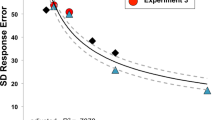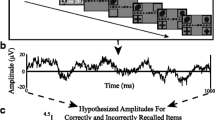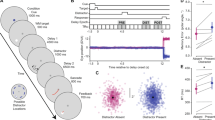Abstract
It has recently been suggested that visual working memory capacity may vary depending on the type of material that has to be memorized. Here, we use a delayed match-to-sample paradigm and event-related potentials (ERP) to investigate the neural correlates that are linked to these changes in capacity. A variable number of stimuli (1–4) were presented in each visual hemifield. Participants were required to selectively memorize the stimuli presented in one hemifield. Following memorization, a test stimulus was presented that had to be matched against the memorized item(s). Two types of stimuli were used: one set consisting of discretely different objects (discrete stimuli) and one set consisting of more continuous variations along a single dimension (continuous stimuli). Behavioral results indicate that memory capacity was much larger for the discrete stimuli, when compared with the continuous stimuli. This behavioral effect correlated with an increase in a contralateral negative slow wave ERP component that is known to be involved in memorization. We therefore conclude that the larger working memory capacity for discrete stimuli can be directly related to an increase in activity in visual areas and propose that this increase in visual activity is due to interactions with other, non-visual representations.






Similar content being viewed by others
References
Alvarez GA, Cavanagh P (2004) The capacity of visual short-term memory is set both by visual information load and by number of objects. Psychol Sci 15(2):106–111
Awh E, Barton B, Vogel EK (2007) Visual working memory represents a fixed number of items regardless of complexity. Psychol Sci 18(7):622–628
Baddeley A (1992) Working memory. Science 255:556–559
Bor D, Duncan J, Wiseman RJ, Owen AM (2003) Encoding strategies dissociate prefrontal activity from working memory demand. Neuron 37(2):361–367
Bor D, Cumming N, Scott CEL, Owen AM (2004) Prefrontal cortical involvement in verbal encoding strategy. Eur J Neurosci 19(12):3365–3370
Brisson B, Jolicœur P (2008) Delayed transfer to visual short-term memory follows express attentional shifts after an invalid predictive spatial cue: evidence from the n2pc and spcn. Vis Cogn 16(8):1097–1101
Courtney SM, Ungerleider LG, Keil K, Haxby JV (1997) Transient and sustained activity in a distributed neural system for human working memory. Nature 386:608–611
Cowan N (1998) Visual and auditory working memory capacity. Trends Cogn Sci 2(3):77–78
Cowan N (2001) The magical number 4 in short-term memory: a reconsideration of mental storage capacity. Behav Brain Sci 24(1):87
Curby KM, Glazek K, Gauthier I (2009) A visual short-term memory advantage for objects of expertise. J Exp Psychol Hum Percept Perform 35(1):94–107
Dent K, Smyth MM (2005) Verbal coding and the storage of form-position associations in visual-spatial short-term memory. Acta Psychol (Amst) 120(2):113–140
Drew TW, McCollough AW, Vogel EK (2006) Event-related potential measures of visual working memory. Clin EEG Neurosci 37(4):286–291
Gao Z, Li J, Liang J, Chen H, Yin J, Shen M (2009) Storing fine detailed information in visual working memory—evidence from event-related potentials. J Vis 9(7):1–12
Hickey C, McDonald JJ, Theeuwes J (2006) Electrophysiological evidence of the capture of visual attention. J Cogn Neurosci 18(4):604–613
Ikkai A, McCollough AW, Vogel EK (2010) Contralateral delay activity provides a neural measure of the number of representations in visual working memory. J Neurophysiol 103(4):1963–1968
Jiang YH, Olson IR, Chun MM (2000) Organization of visual short-term memory. J Exp Psychol Learn Mem Cogn 26(3):683–702
Kenemans JL, Molenaar PCM, Verbaten MN, Slangen JL (1991) Removal of the ocular artifact from the eeg: a comparison of time and frequency domain methods with simulated and real data. Psychophysiology 28(1):114–121
Klaver P, Smid HGOM, Heinze HJ (1999a) Representations in human visual short-term memory: an event-related brain potential study. Neurosci Lett 268(2):65–68
Klaver P, Talsma D, Wijers AA, Heinze HJ, Mulder G (1999b) An event-related brain potential correlate of visual short-term memory. NeuroReport 10(10):2001–2005
Lange JJ, Wijers AA, Mulder LJM, Mulder G (1999) Erp effects of spatial attention and display search with unilateral and bilateral stimulus displays. Biol Psychol 50(3):203–233
Luck SJ, Vogel EK (1997) The capacity of visual working memory for features and conjunctions. Nature 390(6657):279–281
Luria R, Sessa P, Gotler A, Jolicœur P, Dell’Acqua R (2010) Visual short-term memory capacity for simple and complex objects. J Cogn Neurosci 22(3):496–512
McCollough AW, Machizawa MG, Vogel EK (2007) Electrophysiological measures of maintaining representations in visual working memory. Cortex 43(1):77–94
Olsson H, Poom L (2005) Visual memory needs categories. Proc Natl Acad Sci USA 102(24):8776–8780
Pashler H (1988) Familiarity and visual change detection. Percept Psychophys 44(4):369–378
Poom L, Olsson H (2009) Binding feature dimensions in visual short-term memory. Acta Psychol (Amst) 131(1):85–91
Predovan D, Prime D, Arguin M, Gosselin F, Dell’Acqua R, Jolicœur P (2009) On the representation of words and nonwords in visual short-term memory: evidence from human electrophysiology. Psychophysiology 46(1):191–199
Ruchkin DS, Johnson R Jr, Grafman J, Canoune H, Ritter W (1996) Multiple visuospatial working memory buffers: evidence from spatiotemporal patterns of brain activity. Neuropsychologia 35(2):195–209
Talsma D (2008) Auto-adaptive averaging: detecting artifacts in event-related potential data using a fully automated procedure. Psychophysiology 45(2):216–228
Talsma D, Van Harmelen A-L (2009) Procedures and strategies for optimizing the signal-to-noise ratio in event-related potential data. In: Handy TC (ed) Brain signal analysis: advances in neuroelectric and neuromagnetic methods. MIT Press, Cambridge, pp 205–224
Talsma D, Woldorff MG (2005) Methods for the estimation and removal of artifacts and overlap in erp waveforms. In: Handy TC (ed) Event-related potentials: a methods handbook. MIT Press, Cambridge
Talsma D, Wijers AA, Klaver P, Mulder G (2001) Working memory processes show different degrees of lateralization: evidence from event-related potentials. Psychophysiology 38(3):425–439
Talsma D, Kok A, Ridderinkhof KR (2006) Selective attention to spatial and non-spatial visual stimuli is affected differentially by age: effects on event-related brain potentials and performance data. Int J Psychophysiol 62(2):249–261
Todd JJ, Marois R (2004) Capacity limit of visual short-term memory in human posterior parietal cortex. Nature 428(6984):751–754
Ungerleider LG, Courtney SM, Haxby JV (1998) A neural system for human visual working memory. Proc Natl Acad Sci U S A 95(3):883–890
Vogel EK, Machizawa MG (2004) Neural activity predicts individual differences in visual working memory capacity. Nature 428(6984):748–751. doi:10.1038/Nature02447
Vogel EK, Woodman GF, Luck SJ (2001) Storage of features, conjunctions, and objects in visual working memory. J Exp Psychol Hum Percept Perform 27(1):92–114
Vogel EK, McCollough AW, Machizawa MG (2005) Neural measures reveal individual differences in controlling access to working memory. Nature 438(7067):500–503. doi:10.1038/Nature04171
Wong JH, Peterson MS, Thompson JC (2008) Visual working memory capacity for objects from different categories: a face-specific maintenance effect. Cognition 108(3):719–731
Acknowledgments
Data collection was conducted at the Vrije Universiteit, Amsterdam. We wish to thank Paul Groot and Jarik den Hartog for technical support. The first author was supported by the SYLFF. A small subset of data collected in this study has been used by Talsma (2008) for the purpose of validating an EEG artifact detection method.
Author information
Authors and Affiliations
Corresponding author
Rights and permissions
About this article
Cite this article
Diamantopoulou, S., Poom, L., Klaver, P. et al. Visual working memory capacity and stimulus categories: a behavioral and electrophysiological investigation. Exp Brain Res 209, 501–513 (2011). https://doi.org/10.1007/s00221-011-2536-z
Received:
Accepted:
Published:
Issue Date:
DOI: https://doi.org/10.1007/s00221-011-2536-z




